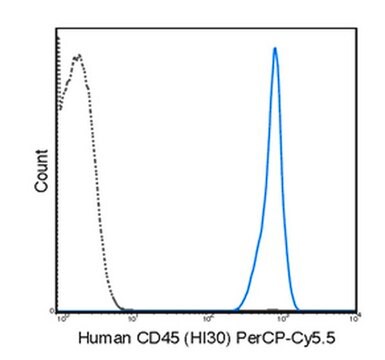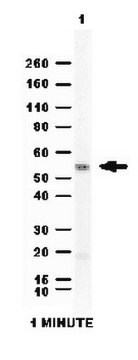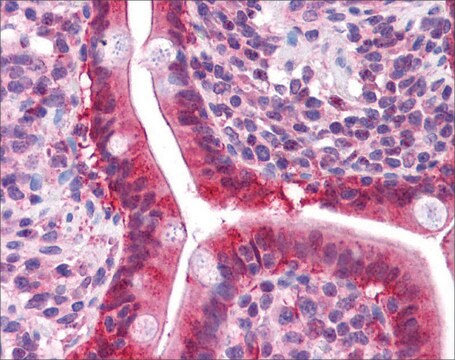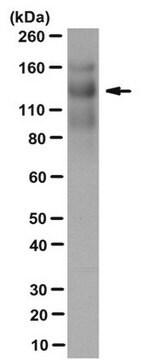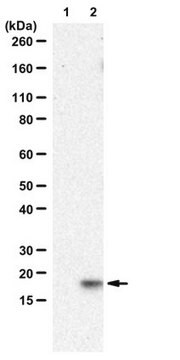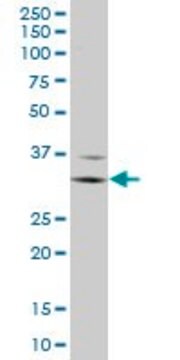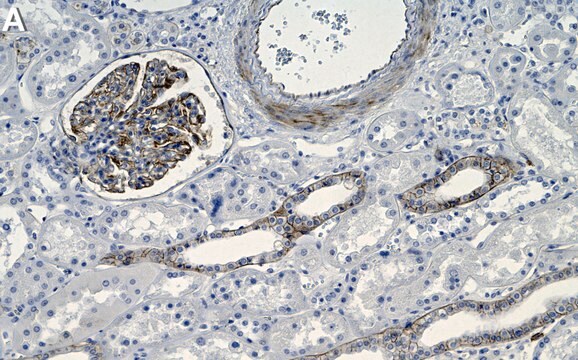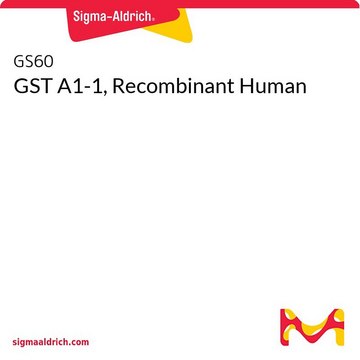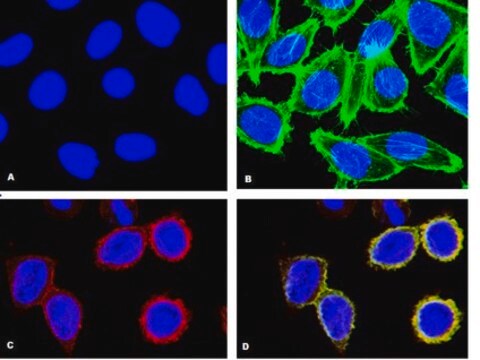おすすめの製品
由来生物
rabbit
品質水準
抗体製品の状態
serum
抗体製品タイプ
primary antibodies
クローン
polyclonal
交差性
rat, human, mouse
テクニック
immunohistochemistry: suitable (paraffin)
western blot: suitable
NCBIアクセッション番号
UniProtアクセッション番号
輸送温度
dry ice
ターゲットの翻訳後修飾
unmodified
遺伝子情報
human ... GSTT1(2952)
詳細
Glutathione S-transferase theta-1 (EC 2.5.1.18; UniProt P30711; also known as Glutathione S-transferase T1-1, GST class-theta-1, GST T1-1) is encoded by the GSTT1 gene (Gene ID 2952) in human. Glutathione S-transferases constitute a family of metabolic isozymes that are involved in detoxification by catalyzing the conjugation of the reduced form of glutathione (GSH) to xenobiotic substrates. The GST family can be subdivided into the cytosolic, mitochondrial, and microsomal (a.k.a. MAPEG) proteins. Mammalian GSTs exist as either homodimers or heterodimers. The individual monomers were historically characterized by their quaternary structure and size, Yf (24.5 kDa), Yk (25 kDa), Ya1 (25.5 kDa), Ya2 (25.5 kDa), Yn (26.5 kDa), Yb1 (27 kDa), Yb2 (27 kDa) and Yc (28.5 kDa). The Y designation refers to the Y fraction (as apposed to the X and Z fractions) they were found in during purification by Sephadex G75 chromatography. Two GST superfamilies exist that comprise either cytosolic or membrane-bound proteins. Evidence suggests that cytosolic GST increases bodily resistance to carcinogens, products of oxidative stress, environmental pollutants and certain anti-cancer drugs. The cytosolic GSTs are further subdivided into eight classes. namely alpha (GSTA), mu (GSTM), pi (GSTP), sigma, theta (GSTT), kappa (GSTK), zeta (GSTZ), and omega (GSTO). GSTT1 exists as a homodimer, the subunit is referred to as subunit 5 in rat species, and T1-1 theta subunit in human.
特異性
Expected to react with both spliced isoforms reported by UniProt (P30711). Note that not all human samples are positive for GSTT1 expression. It has been estimated that approx. 18% of the Caucasian, and as much as 60% of the Chinese and Korean populations are GSTT1-null (Katoh, T., et al. (1996) Carcinogenesis. 17(9):1855-1859; Lear, J.T., et al. (1996) Carcinogenesis. 17(9):1891-1896;).
免疫原
His-tagged recombinant full-length human GSTT1.
アプリケーション
Research Category
細胞シグナル伝達
細胞シグナル伝達
Research Sub Category
酸化ストレス
酸化ストレス
Anti-GSTT1 Antibody is an antibody against GSTT1 for use in Western Blotting, Immunohistochemistry (Paraffin).
Western Blotting Analysis: A representative lot detected recombinant human and murine GSTT1, as well as endogenous GSTT1 in human and mouse liver samples (Sherratt, P.J., et al. (2002). Toxicol. Appl. Pharmacol. 179(2):89-97),
Western Blotting Analysis: A representative lot detected significantly upregulated GSTT1 levels in liver cytosolic preparations from rats on a selenium-deficient diet (McLeod, R., et al. (1997). Cancer Res. 57(19):4257-4266).
Western Blotting Analysis: A representative lot detected recombinant human GSTT1, as well as endogenous human GSTT1 in multiple tissue samples from four deseased individuals (Sherratt, P.J., et al. (1997). Biochem. J. 326 (Pt 3):837-846).
Immunohistochemistry Analysis: A representative lot detected differential GSTT1 immunoreactivity among liver cells in formalin-fixed, paraffin-embedded human and mouse liver tissue sections (Sherratt, P.J., et al. (2002). Toxicol. Appl. Pharmacol. 179(2):89-97).
Western Blotting Analysis: A representative lot detected significantly upregulated GSTT1 levels in liver cytosolic preparations from rats on a selenium-deficient diet (McLeod, R., et al. (1997). Cancer Res. 57(19):4257-4266).
Western Blotting Analysis: A representative lot detected recombinant human GSTT1, as well as endogenous human GSTT1 in multiple tissue samples from four deseased individuals (Sherratt, P.J., et al. (1997). Biochem. J. 326 (Pt 3):837-846).
Immunohistochemistry Analysis: A representative lot detected differential GSTT1 immunoreactivity among liver cells in formalin-fixed, paraffin-embedded human and mouse liver tissue sections (Sherratt, P.J., et al. (2002). Toxicol. Appl. Pharmacol. 179(2):89-97).
品質
Evaluated by Western Blotting in human liver tissue lysate.
Western Blotting Analysis: A 1:5,000 dilution of this antibody detected glutathione S-transferase theta-1 (GSTT1) in 10 µg of human liver tissue lysate.
Western Blotting Analysis: A 1:5,000 dilution of this antibody detected glutathione S-transferase theta-1 (GSTT1) in 10 µg of human liver tissue lysate.
ターゲットの説明
~27 kDa observed (monomer). 27.3 kDa (isoform 1) and 13.5 kDa (isoform 2) calculated.
物理的形状
Unpurified
Rabbit polyclonal antibody in serum with 0.05% sodium azide.
保管および安定性
Stable for 1 year at -20°C from date of receipt.
Handling Recommendations: Upon receipt and prior to removing the cap, centrifuge the vial and gently mix the solution. Aliquot into microcentrifuge tubes and store at -20°C. Avoid repeated freeze/thaw cycles, which may damage IgG and affect product performance.
Handling Recommendations: Upon receipt and prior to removing the cap, centrifuge the vial and gently mix the solution. Aliquot into microcentrifuge tubes and store at -20°C. Avoid repeated freeze/thaw cycles, which may damage IgG and affect product performance.
その他情報
Concentration: Please refer to lot specific datasheet.
免責事項
Unless otherwise stated in our catalog or other company documentation accompanying the product(s), our products are intended for research use only and are not to be used for any other purpose, which includes but is not limited to, unauthorized commercial uses, in vitro diagnostic uses, ex vivo or in vivo therapeutic uses or any type of consumption or application to humans or animals.
適切な製品が見つかりませんか。
製品選択ツール.をお試しください
保管分類コード
12 - Non Combustible Liquids
WGK
WGK 1
引火点(°F)
Not applicable
引火点(℃)
Not applicable
適用法令
試験研究用途を考慮した関連法令を主に挙げております。化学物質以外については、一部の情報のみ提供しています。 製品を安全かつ合法的に使用することは、使用者の義務です。最新情報により修正される場合があります。WEBの反映には時間を要することがあるため、適宜SDSをご参照ください。
Jan Code
ABS1653:
試験成績書(COA)
製品のロット番号・バッチ番号を入力して、試験成績書(COA) を検索できます。ロット番号・バッチ番号は、製品ラベルに「Lot」または「Batch」に続いて記載されています。
Philip J Sherratt et al.
Toxicology and applied pharmacology, 179(2), 89-97 (2002-03-09)
Dichloromethane (DCM) is a hepatic and pulmonary carcinogen in mice exposed to high doses by inhalation. It has been shown previously that the incidence of liver and lung tumors does not increase in rats or hamsters exposed to the dihaloalkane
P J Sherratt et al.
The Biochemical journal, 326 ( Pt 3), 837-846 (1997-10-23)
The cDNA encoding human glutathione S-transferase (GST) T1 has been expressed as two recombinant forms in Escherichia coli that could be purified by affinity chromatography on either IgG-Sepharose or nickel-agarose; one form of the transferase was synthesized from the pALP
R McLeod et al.
Cancer research, 57(19), 4257-4266 (1997-10-23)
Fischer 344 rats fed on a diet that is deficient in selenium are more resistant to the hepatocarcinogen aflatoxin B1 (AFB1) than those fed on a selenium-sufficient diet. Hepatic cytosol from either selenium-deficient Fischer 344 rats or Hooded Lister rats
Amanda Degner et al.
Chemical research in toxicology, 33(7), 1698-1708 (2020-04-03)
Smoking-induced lung cancer is a major cause of cancer mortality in the US and worldwide. While 11-24% of smokers will develop lung cancer, risk varies among individuals and ethnic/racial groups. Specifically, African American and Native Hawaiian cigarette smokers are more
ライフサイエンス、有機合成、材料科学、クロマトグラフィー、分析など、あらゆる分野の研究に経験のあるメンバーがおります。.
製品に関するお問い合わせはこちら(テクニカルサービス)